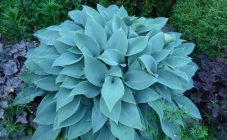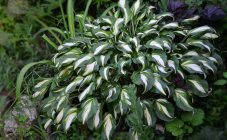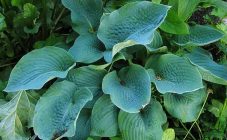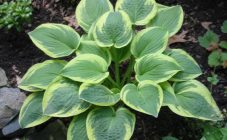Content:
Hosta is a plant that is unpretentious and can grow in one place for several decades. The cultivation process takes place in the open field. There are many varieties. Most hosts are shade-loving plants, but there are a small number of varieties that can grow in the sun. The maximum height is ten centimeters. The varietal qualities of the leaves range from smooth to wavy, from matte to shiny.
The colors are also rich in variety and can be as interesting as blue or pink.
The time when planting hosts will have the best results is the beginning of spring.
History
Hosta Praying Hands (Praying Hands) was registered in 1996 in America. Bred by breeder Jeri Williams. The history of the appearance is unknown, but possibly originates from the hosta Fortunei variety. The name translates as praying hands, thanks to the narrow and elongated leaves. With its decorativeness, this variety stands out among other host, belongs to the collection. The hosts in the garden can be perfectly combined with each other. Compositions of these plants look good near water bodies, on the lawn, along paths and curbs.
Hosta Praying Pens Description
Hosta Praying Hands is a perennial plant. The host reaches 35 centimeters in height, 40 centimeters in diameter, according to these characteristics, the host belongs to the middle group.
The appearance of this variety has an unusual leaf shape. They are narrow, dark in color, with a waxy coating. There is a yellow border around the edge. The leaf is directed upwards, twisted and curved in shape, resembling hands that stretch to the sky in prayer. Flowers have a light lavender color. Blooms in August.
Agricultural technology of cultivation
Reproduction methods
Hosts reproduce in four ways: by dividing the bush, by cuttings, growing from seeds, and vegetatively. Let's consider each of the methods in more detail.
Vegetative propagation is the cultivation of a plant in a test tube. This method is used in industry and is the most effective and large-scale.
The most time consuming method of reproduction is with seeds. The seeds should be planted in April. The probability that the seeds will sprout is 70%. In order to increase germination, the seeds are treated with a growth stimulant before sowing or kept in the cold for a month. Before planting, the soil is disinfected with a manganese solution, containers - with alcohol. Drainage is poured into the container at the bottom, then the prepared soil.
Water the soil well and plant seeds. The containers are covered with foil and placed in a place in the shade with a temperature of + 18-25 degrees. The first shoots will appear in two to three weeks. Watering the seedlings is moderate. The containers are moved to a well-lit place. Direct sunlight will harm the seedlings, so the location should be chosen with this fact in mind. With the appearance of the first pair of leaves, seedlings are planted. The soil in the new containers should be one quarter of sand. In order to harden the sprouts, the film is removed from time to time. After a week, the film can be removed completely.Seedlings are briefly carried out into the garden when the air outside warms up to +18 degrees.
The next breeding method is with cuttings. Its essence lies in the separation of a sprout with a root from an adult plant. After that, the planting material can be planted.
Landing in open ground
Khosta is planted in open ground in early spring or late summer.
Planting material should have elastic roots and two or three buds. The length of the roots is about 12 centimeters.
Before planting, a place is chosen, taking into account the fact that with frequent exposure to sunlight on the plants, their leaves change color from blue to green. When a suitable site is selected, fertilizing and digging should be added to the soil. Fertilizing is humus or compost.
For planting, pits are prepared, the depth of which is 30 centimeters. The distance between the pits is 120 centimeters. Such a long distance is respected for the reason that an adult plant reaches a diameter of 90 to 130 centimeters. When planting, make sure that the stems are above the ground. After the plant is watered, the roots are mulched. Crushed bark or peat serves as mulch. Covering with mulch is necessary to retain moisture. Watering is carried out every 3 days.
Care after landing
After planting, the hosta is regularly loosened and watered. Watering is carried out twice a week. Flowers grow actively, so weeds rarely appear around them.
Top dressing is applied three times per season. This procedure is carried out during growth, during flowering and after flowering. Nitrogen, potassium and phosphorus supplements are suitable. In the autumn, compost and humus are used.
Plants are perennial, growing in one place for several decades (more than twenty years), but bushes should be planted every five years.
In the autumn, the stem with the flower is cut. You do not need to trim the leaves. They are removed in the spring when they rot. As soon as the hosta has faded, the stem is cut off. This is to conserve the hosta's strength, which she would otherwise spend on ripening the seeds.
Diseases rarely affect the plant. Sometimes prone to phylostictosis. The disease is characterized by brown spots. As soon as such signs appear, the plants should be destroyed. The soil needs to be disinfected. Other diseases (gray rot, sclerotinia) are treated with fungicides.
Slugs leave holes in the leaves. To scare away slugs, rubble or broken shells are poured under the bushes. Insecticides are used to control insects.
In regions with a temperate climate, plants take shelter for the winter. Before this, the flower is prepared for the winter period, for this the soil is mulched with grass, sawdust and peat. In the spring, mulch is not harvested, since when it decays, the plant will receive organic fertilizers. The bushes will survive the winter better due to the fact that the leaves are not cut off. Coniferous branches serve as a shelter.
Advantages and disadvantages of the variety
The advantages of the Preing Hands hosta variety are:
- unpretentiousness;
- frost resistance;
- can grow in both shade and on the sunny side;
- unusual leaf shape.
Disadvantages of the Hosta Preing Hands variety:
- moisture-loving;
- belongs to rare breeds.
So, Hosta Praying Hands differs from other varieties with an unusual leaf shape and belongs to rare species. The plant also has all the advantages of the host family: frost resistance, unpretentiousness, undemanding care, and is also rarely exposed to various diseases.
















